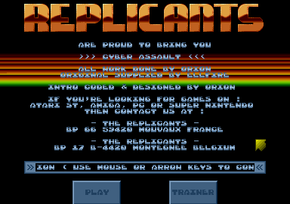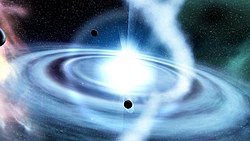Horizontal raster bars
Such computers had limited graphical abilities and usually a fixed number of colours or inks (e.g. a maximum of 16 on the Amstrad CPC) that could be displayed at any one time, which were often assigned from a colour look-up table (CLUT), which maps each displayable colour to one of a larger selection of possible colours (palette) of which the hardware was capable (e.g. 27 on the CPC). Raster bars and similar effects (e.g. having a HUD that uses a different set of colours than does the playing area) are achieved by changing the entries in the CLUT at specific times while the screen is being drawn (originally by the electron beam), in order to display a different set of colours in the subsequent portion of the screen. The most basic raster bar simply affects a single scanline by changing the value in the CLUT for the colour covering that line just before the electron gun draws it, and then changes it back to the previous colour once the line is finished. By using multiple colours in succession and carefully gradating the changes, an effect of metallic-looking horizontal bars can be achieved.
Many graphics chips can trigger an interrupt, specifically called a raster interrupt, when the horizontal blanking interval or the vertical sync begins; thus, an interrupt handler can precisely time and perform the task of updating CLUT entries for raster bars and other colour-changing effects.

The Original Chip Set (OCS) is a chipset used in the earliest Commodore Amiga computers and defined the Amiga's graphics and sound capabilities. It was succeeded by the slightly improved Enhanced Chip Set (ECS) and the greatly improved Advanced Graphics Architecture (AGA).

Parallax scrolling is a technique in computer graphics where background images move past the camera more slowly than foreground images, creating an illusion of depth in a 2D scene of distance. The technique grew out of the multiplane camera technique used in traditional animation since the 1930s.
A vertical blank interrupt is a hardware feature found in some legacy computer systems that generate a video signal. Cathode-ray tube based video display circuits generate vertical blanking and vertical sync pulses when the display picture has completed and the raster is being returned to the start of the display. With VBI, the vertical blank pulse is also used to generate an interrupt request for the computer's microprocessor.

In a raster scan display, the vertical blanking interval (VBI), also known as the vertical interval or VBLANK, is the time between the end of the final visible line of a frame or field and the beginning of the first visible line of the next frame or field. It is present in analog television, VGA, DVI and other signals.

The Commodore 64 (C64) demos are demonstrations of what can be done to push the limits of the Commodore 64 computer, made by programmers, musicians and artists.

The VIC-II, specifically known as the MOS Technology 6567/6566/8562/8564, 6569/8565/8566 (PAL), is the microchip tasked with generating Y/C video signals and DRAM refresh signals in the Commodore 64 and Commodore 128 home computers.

The Television Interface Adaptor (TIA) is the custom computer chip, along with a variant of the MOS Technology 6502 constituting the heart of the 1977 Atari Video Computer System game console. The TIA generates the screen display, sound effects, and reads the controllers. At the time the Atari VCS was designed, even small amounts of RAM were expensive. The chip was designed around not having a frame buffer, instead requiring detailed programming to create even a simple display.

Alphanumeric Television Interface Controller (ANTIC) is an LSI ASIC dedicated to generating 2D computer graphics to be shown on a television screen or computer display. Under the direction of Jay Miner, the chip was designed in 1977–1978 by Joe Decuir, Francois Michel, and Steve Smith for the Atari 8-bit computers first released in 1979. The chip was patented by Atari, Inc. in 1981. ANTIC is also used in the 1982 Atari 5200 video game console, which shares most of the same hardware as the 8-bit computers.

The Motorola 6845, or MC6845, is a display controller that was widely used in 8-bit computers during the 1980s. Originally intended for designs based on the Motorola 6800 CPU and given a related part number, it was more widely used alongside various other processors, and was most commonly found in machines based on the Zilog Z80 and MOS 6502.
Overscan is a behaviour in certain television sets in which part of the input picture is cut off by the visible bounds of the screen. It exists because cathode-ray tube (CRT) television sets from the 1930s to the early 2000s were highly variable in how the video image was positioned within the borders of the screen. It then became common practice to have video signals with black edges around the picture, which the television was meant to discard in this way.
A display list, also called a command list in Direct3D 12 and a command buffer in Vulkan, is a series of graphics commands so that they may be later run when the list is executed. Systems that make use of display list functionality are called retained mode systems, while systems that do not are as opposed to immediate mode systems. In OpenGL, display lists are useful to redraw the same geometry or apply a set of state changes multiple times. This benefit is also used with Direct3D 12's bundle command lists. In Direct3D 12 and Vulkan, display lists are regularly used for per-frame recording and execution.
Horizontal blanking interval refers to a part of the process of displaying images on a computer monitor or television screen via raster scanning. CRT screens display images by moving beams of electrons very quickly across the screen. Once the beam of the monitor has reached the edge of the screen, it is switched off, and the deflection circuit voltages are returned to the values they had for the other edge of the screen; this would have the effect of retracing the screen in the opposite direction, so the beam is turned off during this time. This part of the line display process is the Horizontal Blank.

A video display controller (VDC), also called a display engine or display interface, is an integrated circuit which is the main component in a video-signal generator, a device responsible for the production of a TV video signal in a computing or game system. Some VDCs also generate an audio signal, but that is not their main function. VDCs were used in the home computers of the 1980s and also in some early video picture systems.
A raster interrupt is an interrupt signal in a legacy computer system which is used for display timing. It is usually, though not always, generated by a system's graphics chip as the scan lines of a frame are being readied to send to the monitor for display. The most basic implementation of a raster interrupt is the vertical blank interrupt.

A raster scan, or raster scanning, is the rectangular pattern of image capture and reconstruction in television. By analogy, the term is used for raster graphics, the pattern of image storage and transmission used in most computer bitmap image systems. The word raster comes from the Latin word rastrum, which is derived from radere ; see also rastrum, an instrument for drawing musical staff lines. The pattern left by the lines of a rake, when drawn straight, resembles the parallel lines of a raster: this line-by-line scanning is what creates a raster. It is a systematic process of covering the area progressively, one line at a time. Although often a great deal faster, it is similar in the most general sense to how one's gaze travels when one reads lines of text.

The demo effect is a name for computer-based real-time visual effects found in demos created by the demoscene.
The English Software Company, later shortened to English Software, was a Manchester, UK-based video game developer and publisher that operated from 1982 until 1987. Starting with its first release, the horizontally scrolling shooter Airstrike, English Software focused on Atari 8-bit computers of home, then expanded to other platforms. The company used the slogan "The power of excitement".
Composite artifact colors is a designation commonly used to address several graphic modes of some 1970s and 1980s home computers. With some machines, when connected to an NTSC TV or monitor over composite video outputs, the video signal encoding allowed for extra colors to be displayed, by manipulating the pixel position on screen, not being limited by each machine's hardware color palette.












